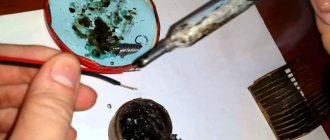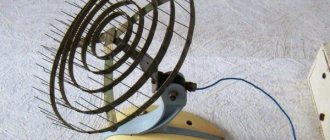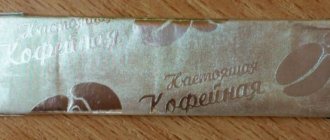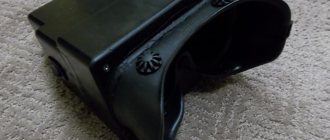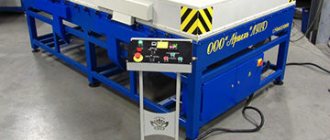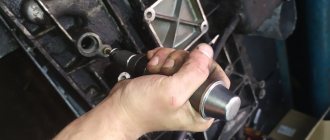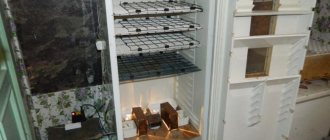Oil separators are recommended for systems:
- working at low temperatures;
- with immiscible refrigerants;
- with evaporators that do not return oil - flooded evaporators;
- with oil bypass lines;
- with variable performance;
- with a long vertical suction or discharge pipeline.
Although properly installed oil separators are usually very good at separating oil from refrigerant vapor, they are not 100% effective. Therefore, it is necessary to provide some additional means of removing the small amounts of oil that pass through the separator to other parts of the system.
The design of oil separators in the discharge pipeline is shown in Figure 24.1. The large diameter pipe is equipped with parallel screens and perforated partitions. Refrigerant vapor with lubricant flows from the smaller diameter discharge pipe into the oil separator, as a result of which the vapor velocity decreases. The oil droplets have more kinetic energy and therefore continue to move towards the partition at a higher speed. Since heavy drops cannot quickly change direction and pass through the separator, they settle on the surface of the partitions, and steam passes through the holes. The droplets collect and flow into the base of the oil separator and then back into the compressor through the float control and pipe. Other oil separator designs use centrifugal force, reducing the velocity of steam, and changing the direction of steam to separate the oil. Each device is also based on the difference in kinetic energy between oil and steam.
When using an oil separator in the system, it is important to limit liquid refrigerant from entering the crankcase when the compressor is off. Refrigerant may condense in the oil separator if it is colder there than in the compressor or connecting piping. The liquid level in the separator will rise and open the float control, allowing the mixture of oil and liquid refrigerant to enter the compressor crankcase. To minimize condensation of refrigerant vapor in the separator when the compressor is turned off, it must be installed near the compressor in a warm place. The separator must be well insulated to reduce heat transfer to the environment when the compressor is turned off. To further reduce the possibility of liquid refrigerant from the separator entering the crankcase, the oil return line should be connected to the compressor inlet rather than the crankcase. Thanks to the passages in the compressor, the liquid refrigerant will evaporate rather than mix with the oil in the crankcase.
The oil return line must be equipped with a solenoid valve, sight glass, manual control valve and manual stop valve as shown in Fig. 23.15 in the previous chapter. Determining the oil level through the sight glass, the manual control valve is turned so that the liquid mixture from the oil separator slowly flows into the inlet while the compressor is running. The solenoid valve is connected to the compressor motor starter so that the valve is open only when the compressor is running. This prevents liquid from flowing from the separator into the compressor when the compressor is off, but allows the flow and evaporation of refrigerant into the inlet to be controlled when the compressor is on.
Oil separator functions
The main function of an oil separator is to remove oil from the high pressure refrigerant vapor stream in the discharge line and return it to the compressor. The oil separator prevents increased oil carryover from the compressor crankcase and increases system efficiency by reducing the rate of oil circulation in the refrigeration circuit.
Oil can be returned to the compressor directly (single-compressor units) or through an oil sump-oil level regulator system (multi-compressor units).
Oil separators of different manufacturers and series can differ significantly from each other in internal design and have different oil separation efficiency. In addition, oil separators are produced both sealed and collapsible.
Standard oil separators
Operating principle. When entering the oil separator, refrigerant vapors with oil droplets enter the oil separator housing, where the flow rate drops significantly. Due to the reduction in flow rate, a significant part of the oil droplets and vapors settles in the lower part of the apparatus. The gas then passes through the outlet strainer where the final separation of the oil from the refrigerant occurs. At the bottom of the oil separator is a float mechanism with a needle valve that returns oil back to the compressor.
Cyclonic oil separators
Operating principle. When entering the oil separator, refrigerant vapors with oil droplets enter the spiral part of the device. The flow moves in a spiral and, due to centrifugal force, oil droplets are deposited on the inner surface of the walls of the oil separator. The oil flows down the walls into the lower part of the apparatus, separated from the main part by a special oil separator, which prevents re-absorption of oil. At the bottom of the oil separator is a float mechanism with a needle valve that returns oil back to the compressor.
Read also: Diagrams and groups of connection of power transformer windings
The oil separator and sump design prevents oil from escaping when the refrigeration compressor starts.
To separate oil from refrigerant, various types of oil separators , the efficiency of which depends on the conditions of their use. For example, the degree of oil separation in devices increases with decreasing temperature of the steam entering the oil separator. Oil separators with a filter attachment provide a greater degree of separation with a smaller proportion of oil in the refrigerant vapor entering the device. Bubble oil separators operate with a nominal separation degree if the height of the bubble layer in the apparatus is at least 0.12 m, and the separated oil is continuously removed from the apparatus.
Painting work in a garage or outdoors is simplified if you use a spray gun powered by a compressor. The method has one significant drawback: the air pumped by the compressor has quite high humidity, which will negatively affect the quality of painting. A special moisture separator for the compressor is responsible for removing moisture from the air flow. Is it worth buying it or can you make it yourself? Let's figure it out!
From CDs
The photo below shows how the air washer looks from the inside in its factory version.
Cleaning and humidification occurs due to the use of a large number of plastic discs in the unit, which increases the area of moisture evaporation and the area of contact with the air flow. Thanks to this, the unit works like a water air purifier, since most of the dust sticks to the discs and is washed into the water in the pan. A similar design can be made at home from CDs.
You also need to select the axis on which these disks will be strung. There are many options for what this shaft is made of: it can be a plastic tube of a suitable diameter or a metal tube, but the simplest solution that can be bought on the market is a 10 mm diameter pin with a thread.
You will also need to purchase the required number of washers (you can make it yourself from a piece of plastic), 2 bearings with a suitable seat diameter and nuts.
Next, follow the given algorithm for performing the work.
- Using sandpaper, a sanding wheel or a drill attachment, remove the top (shiny) layer from the discs so that they become rougher and better wetted with water.
- Place the discs on the stud, placing washers between them.
- Secure the discs to the edges of the shaft using nuts. If you are using a plastic tube, then the discs are secured using a plastic washer and a glue gun.
- Place the bearings on the ends of the shaft and secure them with nuts (in the case of a plastic axle, they are glued with a glue gun).
- A pulley must be secured on one side of the shaft. It can be made from three disks glued together, the central one having a diameter 2-3 mm smaller than the side ones. This pulley will be fitted with an elastic band for money.
But before assembling the shaft with disks, it is necessary to decide on the container on which this entire structure will be installed. The length of the shaft should be such that the bearings extend beyond the container and are installed on the corners glued to it, as in the following figure.
It is also necessary to calculate the location on the shaft where the pulley will be attached. It must be located strictly opposite the motor pulley so that the belt does not fly off.
As a sink body, you can use a plastic container with a lid into which a computer cooler is mounted.
To connect the fan to the network, if you are not good with electronic circuits, you can use any ready-made 12V power supply.
The design of the filter-moisture separator and the principle of its operation
Water separators operate according to one of three principles:
- Using centrifugal forces.
- Using substances that adsorb moisture.
- Removing condensate during cooling.
The action of the dehumidifier is to reduce the humidity of the air entering the compressor to optimal values. The easiest way to do this is to use the principle of a conventional cyclone, when the air flow, when rotating around the central axis, is thrown towards the walls of the working tank. More humid air has an increased density, and therefore, condensing on the walls of the tank, flows in the form of drops to the bottom of the tank, from where it is periodically removed with a conventional condensate drain. The task is to create such a speed of air flow that it has a pronounced turbulent character, and the laws of physics will do the rest.
To reduce air humidity, you can also use substances that have active moisture absorption properties. The most common of them is silica gel. It consists of granules of dried silicic acid gels, to which various dyes and stabilizers are added. Silica gel is produced in accordance with the technical requirements of GOST 3956, and differs in the size of the granules, the percentage of water, the size of the working surface and the diameter of the pores in the granules, where moisture is adsorbed. The activity of silica gel extends to a temperature range from 20 to 250ºС. A compressor dehumidifier using silica gel can be found in scuba filters and imported heavy trucks. The device has a block system: when replacing the adsorbent, it is necessary to remove the used granules from the filter and fill the space with fresh silica gel.
The third method is least functional, when the air flow enters the compressor through the refrigerating chamber. The main problem is reliable sealing of the refrigeration chamber, which must be equipped with a condensate drain. When soldering/welding, the maximum air pressure that will enter the refrigeration chamber should be taken into account. Of all types of filter drier for a compressor, the permissible pressure here will be the lowest, which will accordingly affect the painting performance.
A dehumidifier for an industrial compressor is not cheap. For example, the price of a compact filter-moisture separator of the Caliber brand (designed for excess air pressure up to 8...10 atm) is 1600...1800 rubles. And for the multifunctional station Hans (Germany) with a pressure regulator and lubricator (nominal pressure - up to 10 atm) the price is already 7,500 rubles.
There are also combined designs. For example, a moisture separator can be easily obtained from coarse filters from SATA (Germany) or WALCOM (Italy). To do this, a deflector is built into the existing circuit diagram of the unit (regular, automobile, has too large dimensions), and in the lower part of the device it is necessary to replace the solid bottom with an annular one, into which a float or nozzle type condensate drain must be welded.
DIY compressor dehumidifier
Homemade cyclone type moisture separator
If it is not possible to get a coarse filter from DAF or Iveco trucks (such filters are the easiest to adapt), then there is nothing impossible in making the device in question with your own hands.
For a cyclone dehumidifier you will need an old liquefied gas cylinder (or fire extinguisher body), an adapter fitting and two metal tubes. First, a hole is made at the bottom of the cylinder for a condensate drain (but you can do without this if you weld a regular tap into the bottom of the lower part of the cylinder or body). The outlet fitting is welded into the top of the cylinder.
Three legs are welded along the perimeter of the body at an angle of 120º. The legs are equipped with heels for a stable position of the dehumidifier. After this, the body can be painted. The inlet pipe is welded in such a way that there is a distance of at least 120...150 mm between it and the condensate drain valve.
A steel mesh filter can be attached to the upper fitting. To do this, the upper fitting is made as a composite: first, a thick-walled washer with a mesh is welded between it and the body, and then the upper fitting is welded to it. However, such reinsurance is only needed if the air in the room where painting is performed is contaminated with fine dust.
Read also: Homemade products from a washing machine drum
Homemade adsorption type dehumidifier
In order to make this type of dehumidifier for a compressor, you need to use an oil or water filter from any car. The housing and placement of fittings, as well as the location of the condensate drain, do not change. A steel tube (preferably with a built-in filter) is installed in the inlet hole of the filter, and the second hole is plugged using a threaded plug, which is seated on the sealant.
The annular space between the inner wall of the housing and the outer diameter of the filter is filled with adsorbent. In order for moisture absorption to occur gradually, rubber sealing rings are used, with the help of which the entire space of the housing can be divided into 3 zones. You will need two o-rings. But, if the compressor dehumidifier is not used often for its intended purpose, you can fill the entire annular gap with silica gel.
All that remains is to assemble the device and attach it to the body. Calculation of the amount of silica gel is carried out from the practical ratio of 1 kg of adsorbent per 800...850 l/min of air. Silica gel is a regenerable substance: to do this, just leave it in the oven for several hours. Silica gel with a color indicator is more convenient: when all the pores in the substance are clogged with moisture, its color changes, which is the basis for replacing it.
This is not a flaw or design flaw. A compressor of this type has found its wide application in various work processes that do not require high-quality preliminary preparation of the air mass. Models without an oil tank are equipped with a filtration system. To do this, use a compress moisture separator , which helps separate the oil components and the incoming air flow.
Main settings
If there is a need to adjust the humidity conditions in the room, you should take a responsible approach to choosing the appropriate device. The climate solutions presented in this segment differ in their technical characteristics.
Performance. Each unit can provide removal of a certain amount of moisture. This criterion is measured in l/day. It is necessary to focus on products that can maintain optimal humidity conditions. If you buy a unit with insufficient performance, it will function without stopping, which can lead to overheating and early failure. Powerful devices overuse electricity.
Tank volume. This criterion is relevant only in cases where it is necessary to service large premises.
Electricity consumption. The value is directly related to the power of the unit. However, there are also models on the market that combine not only high power, but also low power consumption.
Air exchange level. The volume of the room where drying is planned must be taken into account. This value must be compared with the volume of air for which the household or industrial appliance is designed. The ratio should be 1 to 4 in favor of the unit.
Auto restart function. An indispensable addition for devices operating in blackout conditions.
Acoustic effect. The optimal value is 40-50 dB. If this value is exceeded, the device will only cause constant acoustic discomfort.
Household devices are complemented by a number of other functions: ultraviolet lighting, oxygen purification and removal of contaminated air masses. The price tag for such devices is often higher than conventional solutions.
Device Description
By dehumidifier we mean a high quality filtration agent. It ensures optimal operating characteristics of the equipment, and also cleans the composition of the air environment that is released by the pneumatic system. Modern compressor models are often supplemented with a panel or oil filter, which thoroughly prepares the working mixture.
This is an important filtration stage for a pneumatic system that maintains oversized tools. Standard models of compressor dehumidifiers are more often used in automotive workshops, as well as on production lines where workers perform a large volume of paint and varnish operations.
As a result of thorough cleaning and reprocessing, the pneumatic system releases air that is free of moisture particles. Due to their properties, moisture separators are used for the proper operation and operation of sandblasting construction equipment.
Principle of operation
The dehumidifier begins to process the compressed air before supplying it to the pneumatic equipment. It is important to remember that spray guns cannot be used without this device, so that it does not fail prematurely, as well as to ensure high quality paint application to the surface. During the filtration process, the jet goes through a cleaning stage , so fine liquid particles, as well as small solid elements, are removed from the air.
Depending on the type and design of the device, the operating principle of the dehumidifier may vary slightly. Today, among a large and varied selection, the following options are presented:
The most commonly used are vortex and cyclone dehumidifier devices for compressor equipment. The device helps to effectively retain water particles thanks to the artificially created turbulence of the air flow.
The liquid settles on the surface of the walls, so clean compressed air enters the pneumatic system. To ensure maximum efficiency of the dehumidifier, the internal space is supplemented with blades. When they are set in motion, they carefully collect water and oil particles. They are discharged into a special condensate drain. Liquid fractions are retained and blocked using membranes.
Why do you need a dehumidifier in your apartment?
The most unwanted and unexpected guests in our home are mold and mildew. Their spores are constantly hovering around, but most of the time they are in a state of hibernation, because they need certain conditions to activate:
- humidity;
- high room temperature.
A temperature above 20 degrees Celsius with a relative humidity of 80% is enough for you to see with the naked eye the growth of colonies of mold and fungi on the walls of rooms. Why, in this case, for example, does your neighbor not have similar troubles? The answer is simple: the air temperature in all apartments is most often the same, but the humidity can vary significantly.
Air dryers
In the fight against the effects of dampness, you can, of course, significantly lower the temperature in the apartment. But who wants to live in constant cold? In this regard, the best option is to install a dehumidifier.
Among other things, he will guard the health of the apartment residents. The body's immunity is directly dependent on the humidity of the surrounding air: the drier it is, the more difficult it is for harmful bacteria and microbes to multiply.
Dehumidification will also eliminate perspiration from the windows.
Specifications
The size of the fraction affects the quality of air mass purification. Devices for industrial use are used for fine water treatment. They cut off small particles, the size of which is about 5 microns. Most often, standard models of moisture separators are equipped with filters , the fraction of which is about 15 microns.
When choosing, special attention should be paid to the level of pressure maintained. In most cases, the mid-compressor filter operates at 7 bar. This parameter does not affect the quality of the final work. But users should consider the filter matching plan to the compressors. It is necessary to compare the level of power and load that arise during the circulation of compressed air under pressure within the system.
Types of dehumidifiers
There are several types of dehumidifiers that are used for domestic and industrial purposes. Before purchasing, you need to identify the tasks and compare them with the technical characteristics in order to select the optimal type of dehumidifier. Among the large and varied selection you can find:
- vortex filters;
- modular systems for compressed air purification;
- moisture-oil separator for compressor.
The peculiarity of the latter type of device is its effective removal of water, solids and oil. They are installed on oil compressors, which can intensively process parts using a lubricant. Large manufacturing enterprises with a large volume of work often use modular filtration systems.
Read also: Making balls on a lathe
In this design, the dehumidifier is a functional and important component, but it does not serve as an independent working filter.
The modular system is controlled by a controller, which issues various commands not only to the filter, but also to other nodes in the unit.
Criterias of choice
Depending on the application, the cleaning requirements also change. If you need to paint the surface using a pneumatic gun, but you need to pay attention to the small filter capacity. It is better to give preference to fine cleaning.
There may be minimum filtration quality requirements during the manufacturing process. But in this case, special attention is paid to production volumes. Experts recommend looking at the list of foreign particles that the filter collects. The optimal solution is a moisture-oil separator for a compressor, which processes water and oil particles from an air stream.
If your work requires a filter to collect excess moisture, then you can also purchase dehumidifiers. But they do not guarantee high-quality removal of various fractions, particles and foreign bodies.
Security measures
To ensure that your home-made air dehumidifier works smoothly and does not cause harm, follow the safety rules:
- Install the unit away from flammable elements, water and fires.
- There must be enough space around the moisture absorber for normal air circulation.
- Do not expose the device to direct sunlight when the device is turned on.
- Make sure that pets (cats, dogs) do not knock over the equipment.
- Never block air inlets or outlets.
- Connect the device to a working outlet.
- Periodically inspect the cord and plug for damage.
- When leaving home, turn off the system and do not leave the dehumidifier unattended.
DIY making
A homemade dehumidifier consists of an old or used propane tank, fitting and pipes. The blank for the body is installed in a vertical position. A fitting for air inlet must be welded to the top part. Experts recommend moving it closer to the edges of the cylinder. Next, you need to make an inlet pipe for which you can use a pipe.
To remove moisture, make a hole equipped with a valve. It should be located at the bottom of the structure. At this stage, during the manufacture of the moisture separator, it is necessary to think through, perform calculations and make the filler. Wood shavings are used as a sorbent material, which can be filled into the inner niche of the cylinder. It is important to remember not to pack the container tightly. Air must circulate freely inside the system.
Adsorption type moisture separators
To make such a moisture separator with your own hands for use in compressors, you need to use oil and water filters from a car. There is no need to change the original arrangement of the housing, fittings and drainage device for collecting condensate.
The filter inlet needs to be changed. To do this, install a tube made of durable steel. To ensure stable operation of the device, it is best to use the built-in filter. The second hole is tightly closed with a screw plug. To make it stick better, it needs to be placed on a sealant.
There is an annular space between the inner wall of the housing and the outer diameter of the filter. It must be filled with adsorbent. A person who makes a dehumidifier on his own must remember that moisture absorption must occur gradually. Rubber O-rings are used for this purpose.
They can be used to divide the internal space of the case into three zones. If the dehumidifier will be used infrequently, the internal space and annular gap can be filled with silicate gel. After this, you can assemble the device and process the connecting elements. If you follow these rules, you can make a dehumidifier for a compressor with your own hands at minimal cost.
To calculate the required amount of silicate gel, you must use the following formula: take 1 kg of adsorbent for 830 l/min of compressed air. Silicate gel is a regenerable substance. To restore its original properties, you need to place the substance in the oven for 2-3 hours. Experts recommend using silicate gel, which has a color indicator. When the pores are filled with moisture, the color will change and you can dry it.
Installation Requirements
When operating a dehumidifier, several basic rules and requirements must be taken into account:
- The device can be installed strictly in a vertical position and securely fixed inside the case.
- During connection, you need to check the direction of air movement.
- If you buy a ready-made design, the direction is indicated on the body in the form of arrows.
If these rules are followed, the dehumidifier will function correctly and provide high quality.
Useful tips
Take advantage of simple but effective tips from folk craftsmen and specialists:
- When purchasing a dry moisture absorber, be sure to pay attention to the composition of the silica gel, as you can find options on sale that contain chemical compounds. It is impossible to install a structure with toxic substances in an apartment or house, as this can lead to intoxication of the body.
- When sealing joint areas, additionally seal the seams with tape, silicone or self-adhesive tape.
- Remember that the operation of dehumidifiers is based on the supply-pressure action - air masses are first blown in, then blown back out.
- To increase efficiency, it is recommended to install homemade devices in the central part of the apartment.
- Remember to control the humidity level. For the human body, optimal moisture is 40-60%. The dehumidifier must be turned on when the humidity reaches 65-70%, no less. To check the readings in the room, purchase a hydrometer. Today you can find both arrow and digital options on sale.
- Do not allow the air to dry out, as this has a negative effect on the body. Watch this especially carefully in the summer.
- If you have made an absorption type of moisture absorber, dry it or change the absorbent (salt, silica gel) every few days.
- Along with using the unit, be sure to ventilate the room so that oxygen enters. Don’t forget about cleaning the centralized ventilation system and hoods.
If you make a dehumidifier with your own hands, you will significantly save your family budget, since store-bought options are quite expensive. Homemade systems are especially relevant in rooms with high levels of humidity - bathrooms, kitchens, swimming pools, home baths and saunas, cellars and basements, garages and country houses.
Advantages of cyclone type filters
Water separators greatly simplify the operation of an air gun and compressor. They ensure stable operation of the equipment. The following advantages of cyclone type filters can be highlighted:
- simple design;
- reasonable cost;
- maximum efficiency;
- retention of large condensate particles;
- simple maintenance;
- regeneration and complete restoration of original properties;
- providing preliminary rough cleaning.
Dehumidifiers for compressors and air guns are an effective tool, without which it is impossible to imagine the operation of this equipment. They qualitatively prepare compressed air for further use. Filters separate primary moisture, oil particles, as well as contaminants of various fractions and other solid particles. Any pneumatic network must be equipped with a moisture separator that will clean the air for further use.
“>
What kind of dehumidifier can be used for a home?
There are various types of this technique. A dehumidifier for an apartment or a private house is used as a household one, because it is capable of releasing liquid in quantities of 10 to 100 liters per day. Industrial analogues are much more effective and can remove moisture over 100 liters; they are not advisable to use in everyday life. For apartments, dehumidifiers come in the following varieties:
- wall;
- floor;
- desktop
The last option is small in size, because these models are designed for installation on a table and operate from a power outlet. Wall-mounted devices are mounted on a vertical surface. The floor-standing analogue is characterized by large dimensions, which does not allow the model to be placed on a table or wall. However, this option is capable of drying large volumes of steam, for this reason it is used in facilities with a large area, as well as intensive air humidification. In addition, there are universal devices and hidden moisture absorbers.
Air dryers are divided into groups according to differences in operating principles:
- Condensation type - they work according to the above described scheme.
- Technology operating on the basis of adsorption. In this case, a special type of substance is used, characterized by a porous structure. They absorb moisture from the air. The main disadvantage of such devices is the need to replace the sorbent.
- Air dehumidifiers for apartments, operating on the basis of the assimilation or air exchange method. This is the least effective technique and requires considerable costs. Devices of this type are not capable of drying rooms with intense air humidification.
